A Comprehensive Report Evaluating Climate Change Abatement Program
VerifiedAdded on 2023/04/11
|6
|1078
|89
Report
AI Summary
This report evaluates a climate change abatement program focused on reducing carbon emissions within the transport sector through behavioral changes. The program promotes teleworking and the adoption of electric vehicles to decrease reliance on traditional automobiles and fossil fuels. The evaluation identifies strengths, such as the potential for significant CO2 reduction and economic viability through reduced gasoline consumption, and weaknesses, including limited empirical evidence supporting teleworking's impact and challenges related to infrastructure for electric vehicles and the high initial cost of electric car acquisition. The report suggests policy improvements, such as increased public awareness, flexible work arrangements, and government incentives for electric vehicle purchases, to enhance program effectiveness. It also notes the program's selective targeting of the working class and the need for broader inclusivity. The report concludes by emphasizing the importance of addressing these challenges to maximize the program's environmental impact.
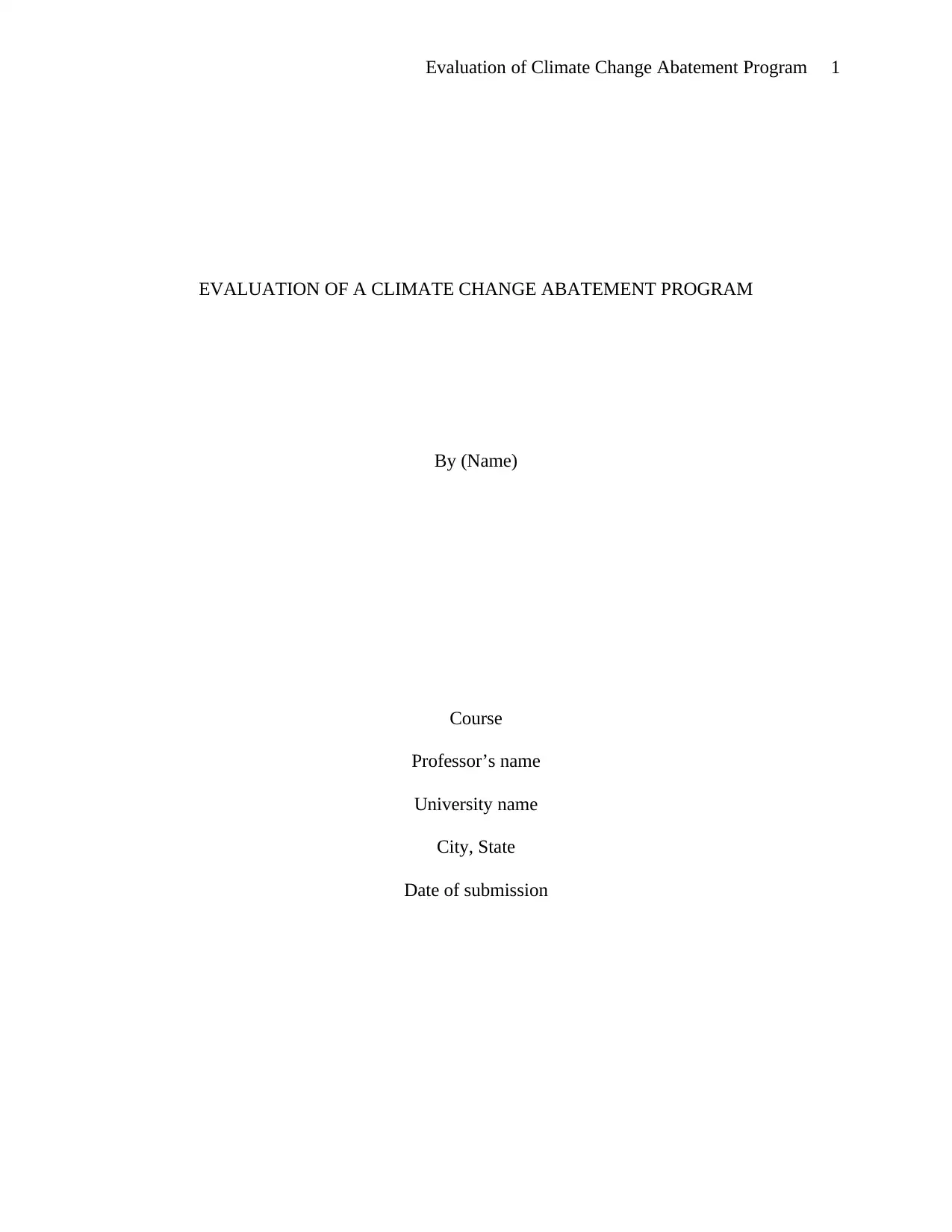
Evaluation of Climate Change Abatement Program 1
EVALUATION OF A CLIMATE CHANGE ABATEMENT PROGRAM
By (Name)
Course
Professor’s name
University name
City, State
Date of submission
EVALUATION OF A CLIMATE CHANGE ABATEMENT PROGRAM
By (Name)
Course
Professor’s name
University name
City, State
Date of submission
Paraphrase This Document
Need a fresh take? Get an instant paraphrase of this document with our AI Paraphraser
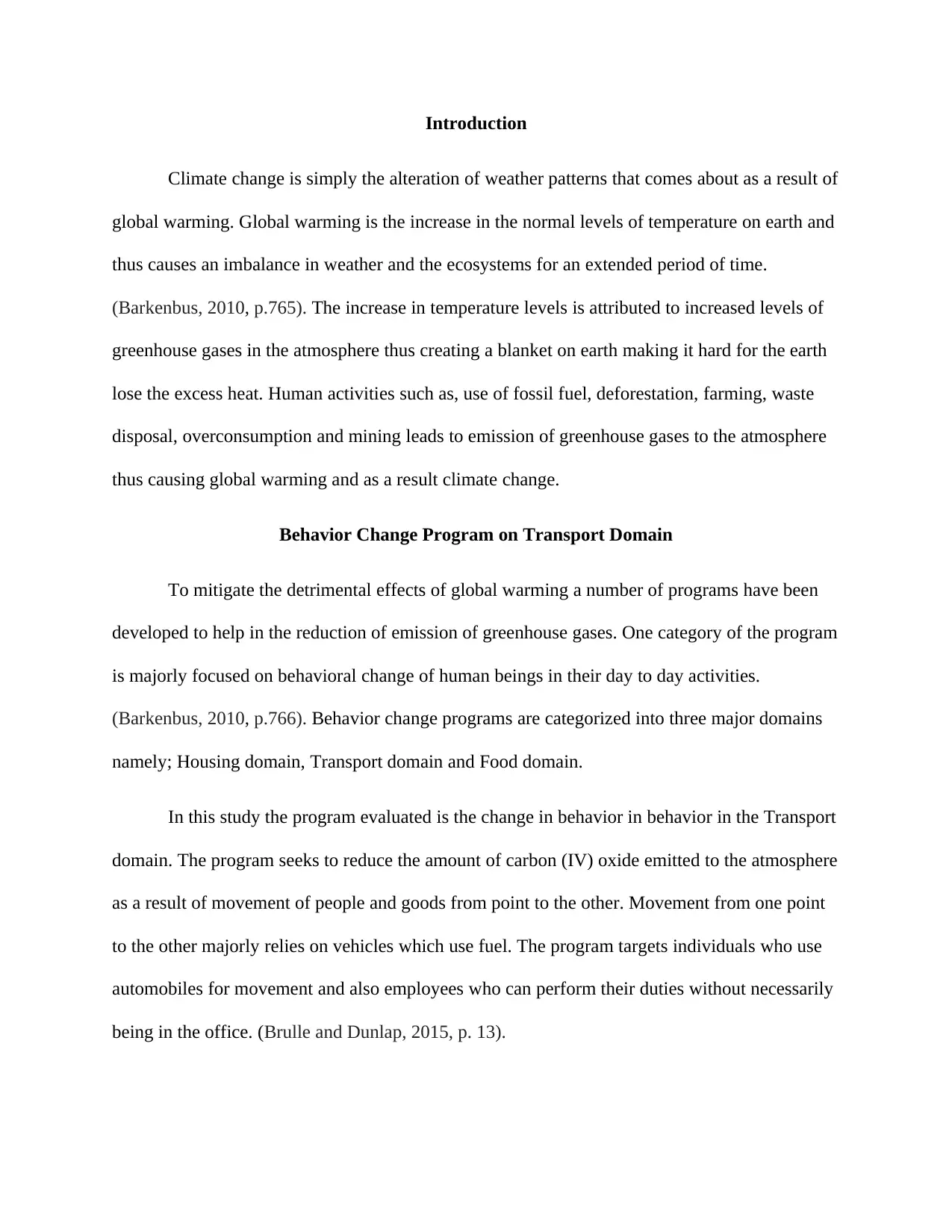
Introduction
Climate change is simply the alteration of weather patterns that comes about as a result of
global warming. Global warming is the increase in the normal levels of temperature on earth and
thus causes an imbalance in weather and the ecosystems for an extended period of time.
(Barkenbus, 2010, p.765). The increase in temperature levels is attributed to increased levels of
greenhouse gases in the atmosphere thus creating a blanket on earth making it hard for the earth
lose the excess heat. Human activities such as, use of fossil fuel, deforestation, farming, waste
disposal, overconsumption and mining leads to emission of greenhouse gases to the atmosphere
thus causing global warming and as a result climate change.
Behavior Change Program on Transport Domain
To mitigate the detrimental effects of global warming a number of programs have been
developed to help in the reduction of emission of greenhouse gases. One category of the program
is majorly focused on behavioral change of human beings in their day to day activities.
(Barkenbus, 2010, p.766). Behavior change programs are categorized into three major domains
namely; Housing domain, Transport domain and Food domain.
In this study the program evaluated is the change in behavior in behavior in the Transport
domain. The program seeks to reduce the amount of carbon (IV) oxide emitted to the atmosphere
as a result of movement of people and goods from point to the other. Movement from one point
to the other majorly relies on vehicles which use fuel. The program targets individuals who use
automobiles for movement and also employees who can perform their duties without necessarily
being in the office. (Brulle and Dunlap, 2015, p. 13).
Climate change is simply the alteration of weather patterns that comes about as a result of
global warming. Global warming is the increase in the normal levels of temperature on earth and
thus causes an imbalance in weather and the ecosystems for an extended period of time.
(Barkenbus, 2010, p.765). The increase in temperature levels is attributed to increased levels of
greenhouse gases in the atmosphere thus creating a blanket on earth making it hard for the earth
lose the excess heat. Human activities such as, use of fossil fuel, deforestation, farming, waste
disposal, overconsumption and mining leads to emission of greenhouse gases to the atmosphere
thus causing global warming and as a result climate change.
Behavior Change Program on Transport Domain
To mitigate the detrimental effects of global warming a number of programs have been
developed to help in the reduction of emission of greenhouse gases. One category of the program
is majorly focused on behavioral change of human beings in their day to day activities.
(Barkenbus, 2010, p.766). Behavior change programs are categorized into three major domains
namely; Housing domain, Transport domain and Food domain.
In this study the program evaluated is the change in behavior in behavior in the Transport
domain. The program seeks to reduce the amount of carbon (IV) oxide emitted to the atmosphere
as a result of movement of people and goods from point to the other. Movement from one point
to the other majorly relies on vehicles which use fuel. The program targets individuals who use
automobiles for movement and also employees who can perform their duties without necessarily
being in the office. (Brulle and Dunlap, 2015, p. 13).
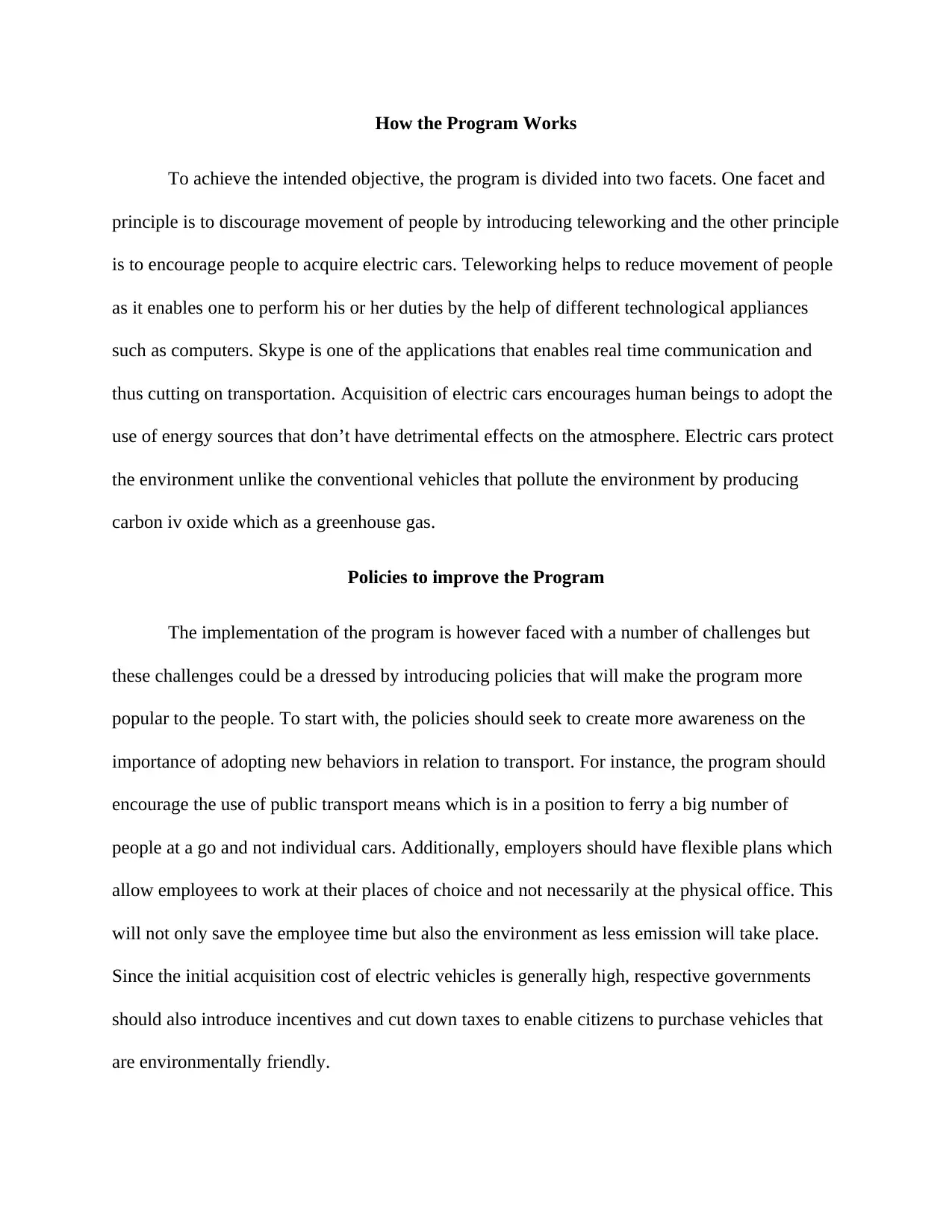
How the Program Works
To achieve the intended objective, the program is divided into two facets. One facet and
principle is to discourage movement of people by introducing teleworking and the other principle
is to encourage people to acquire electric cars. Teleworking helps to reduce movement of people
as it enables one to perform his or her duties by the help of different technological appliances
such as computers. Skype is one of the applications that enables real time communication and
thus cutting on transportation. Acquisition of electric cars encourages human beings to adopt the
use of energy sources that don’t have detrimental effects on the atmosphere. Electric cars protect
the environment unlike the conventional vehicles that pollute the environment by producing
carbon iv oxide which as a greenhouse gas.
Policies to improve the Program
The implementation of the program is however faced with a number of challenges but
these challenges could be a dressed by introducing policies that will make the program more
popular to the people. To start with, the policies should seek to create more awareness on the
importance of adopting new behaviors in relation to transport. For instance, the program should
encourage the use of public transport means which is in a position to ferry a big number of
people at a go and not individual cars. Additionally, employers should have flexible plans which
allow employees to work at their places of choice and not necessarily at the physical office. This
will not only save the employee time but also the environment as less emission will take place.
Since the initial acquisition cost of electric vehicles is generally high, respective governments
should also introduce incentives and cut down taxes to enable citizens to purchase vehicles that
are environmentally friendly.
To achieve the intended objective, the program is divided into two facets. One facet and
principle is to discourage movement of people by introducing teleworking and the other principle
is to encourage people to acquire electric cars. Teleworking helps to reduce movement of people
as it enables one to perform his or her duties by the help of different technological appliances
such as computers. Skype is one of the applications that enables real time communication and
thus cutting on transportation. Acquisition of electric cars encourages human beings to adopt the
use of energy sources that don’t have detrimental effects on the atmosphere. Electric cars protect
the environment unlike the conventional vehicles that pollute the environment by producing
carbon iv oxide which as a greenhouse gas.
Policies to improve the Program
The implementation of the program is however faced with a number of challenges but
these challenges could be a dressed by introducing policies that will make the program more
popular to the people. To start with, the policies should seek to create more awareness on the
importance of adopting new behaviors in relation to transport. For instance, the program should
encourage the use of public transport means which is in a position to ferry a big number of
people at a go and not individual cars. Additionally, employers should have flexible plans which
allow employees to work at their places of choice and not necessarily at the physical office. This
will not only save the employee time but also the environment as less emission will take place.
Since the initial acquisition cost of electric vehicles is generally high, respective governments
should also introduce incentives and cut down taxes to enable citizens to purchase vehicles that
are environmentally friendly.
⊘ This is a preview!⊘
Do you want full access?
Subscribe today to unlock all pages.

Trusted by 1+ million students worldwide
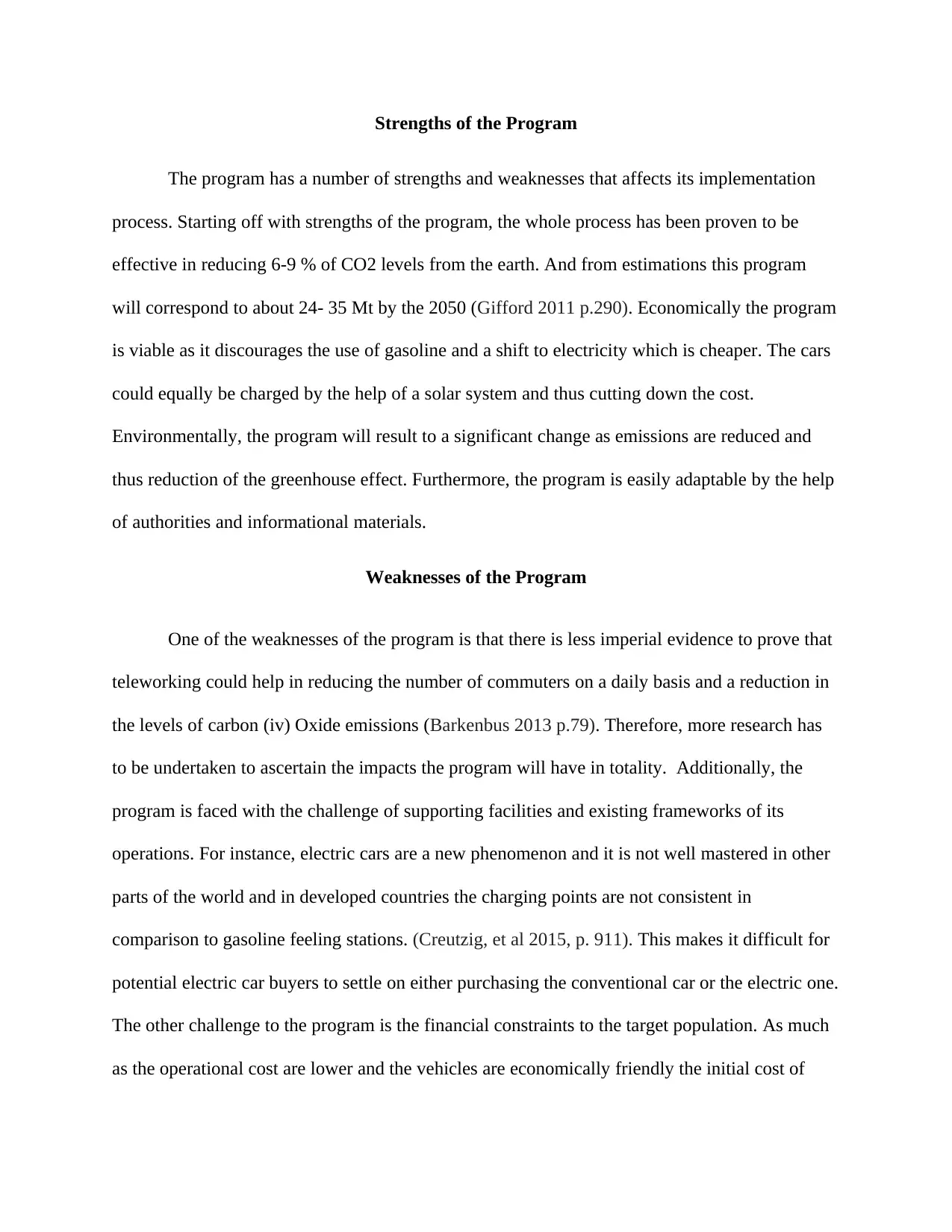
Strengths of the Program
The program has a number of strengths and weaknesses that affects its implementation
process. Starting off with strengths of the program, the whole process has been proven to be
effective in reducing 6-9 % of CO2 levels from the earth. And from estimations this program
will correspond to about 24- 35 Mt by the 2050 (Gifford 2011 p.290). Economically the program
is viable as it discourages the use of gasoline and a shift to electricity which is cheaper. The cars
could equally be charged by the help of a solar system and thus cutting down the cost.
Environmentally, the program will result to a significant change as emissions are reduced and
thus reduction of the greenhouse effect. Furthermore, the program is easily adaptable by the help
of authorities and informational materials.
Weaknesses of the Program
One of the weaknesses of the program is that there is less imperial evidence to prove that
teleworking could help in reducing the number of commuters on a daily basis and a reduction in
the levels of carbon (iv) Oxide emissions (Barkenbus 2013 p.79). Therefore, more research has
to be undertaken to ascertain the impacts the program will have in totality. Additionally, the
program is faced with the challenge of supporting facilities and existing frameworks of its
operations. For instance, electric cars are a new phenomenon and it is not well mastered in other
parts of the world and in developed countries the charging points are not consistent in
comparison to gasoline feeling stations. (Creutzig, et al 2015, p. 911). This makes it difficult for
potential electric car buyers to settle on either purchasing the conventional car or the electric one.
The other challenge to the program is the financial constraints to the target population. As much
as the operational cost are lower and the vehicles are economically friendly the initial cost of
The program has a number of strengths and weaknesses that affects its implementation
process. Starting off with strengths of the program, the whole process has been proven to be
effective in reducing 6-9 % of CO2 levels from the earth. And from estimations this program
will correspond to about 24- 35 Mt by the 2050 (Gifford 2011 p.290). Economically the program
is viable as it discourages the use of gasoline and a shift to electricity which is cheaper. The cars
could equally be charged by the help of a solar system and thus cutting down the cost.
Environmentally, the program will result to a significant change as emissions are reduced and
thus reduction of the greenhouse effect. Furthermore, the program is easily adaptable by the help
of authorities and informational materials.
Weaknesses of the Program
One of the weaknesses of the program is that there is less imperial evidence to prove that
teleworking could help in reducing the number of commuters on a daily basis and a reduction in
the levels of carbon (iv) Oxide emissions (Barkenbus 2013 p.79). Therefore, more research has
to be undertaken to ascertain the impacts the program will have in totality. Additionally, the
program is faced with the challenge of supporting facilities and existing frameworks of its
operations. For instance, electric cars are a new phenomenon and it is not well mastered in other
parts of the world and in developed countries the charging points are not consistent in
comparison to gasoline feeling stations. (Creutzig, et al 2015, p. 911). This makes it difficult for
potential electric car buyers to settle on either purchasing the conventional car or the electric one.
The other challenge to the program is the financial constraints to the target population. As much
as the operational cost are lower and the vehicles are economically friendly the initial cost of
Paraphrase This Document
Need a fresh take? Get an instant paraphrase of this document with our AI Paraphraser

acquiring electrical vehicle is so high and this greatly affects the implementation process. Lastly,
the program is selective in that it targets the working class and those in apposition to acquire
electric cars. No consideration was made in regards to the less fortunate and the disabled on how
they would have contributed to making the world a better place by reducing the amounts of
greenhouse gases in the atmosphere.
the program is selective in that it targets the working class and those in apposition to acquire
electric cars. No consideration was made in regards to the less fortunate and the disabled on how
they would have contributed to making the world a better place by reducing the amounts of
greenhouse gases in the atmosphere.
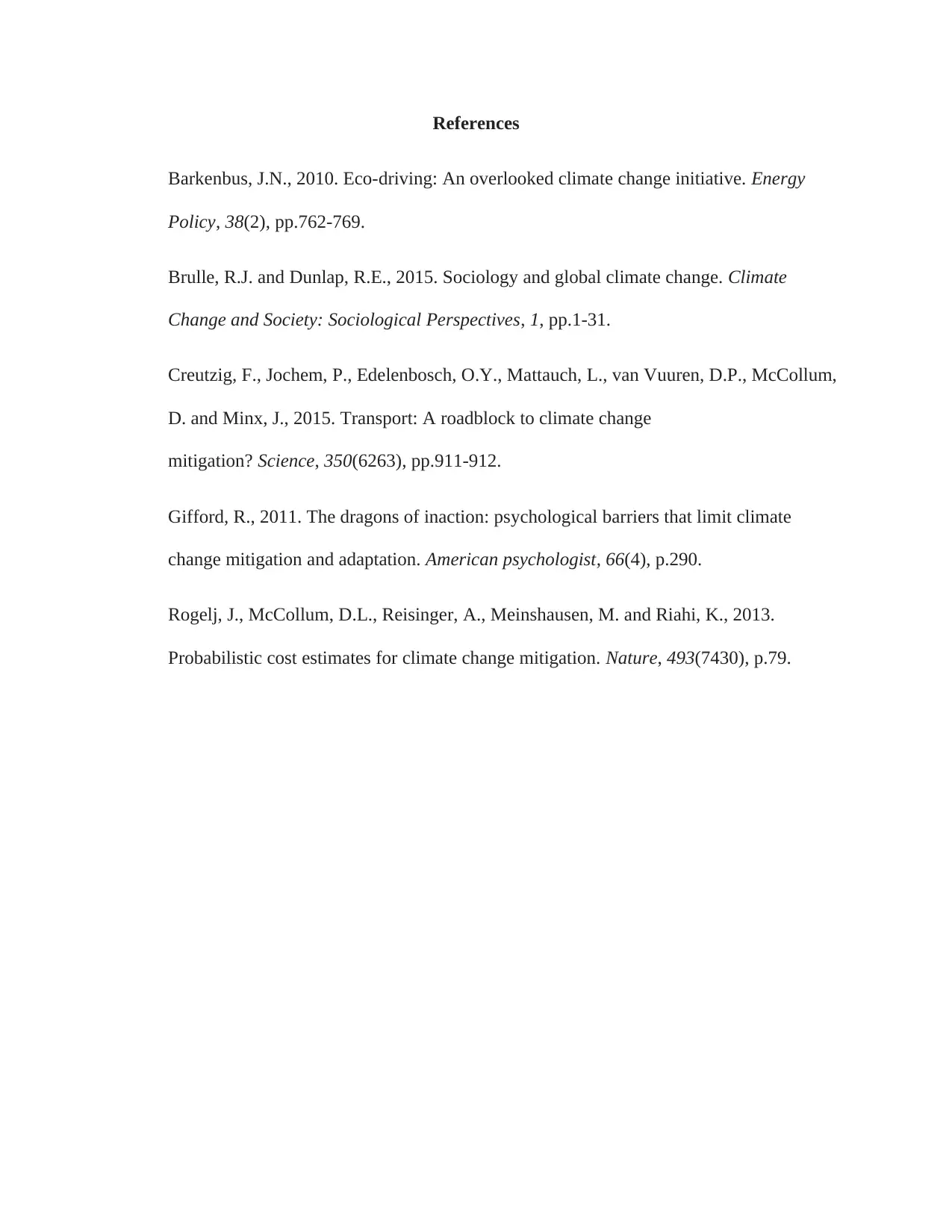
References
Barkenbus, J.N., 2010. Eco-driving: An overlooked climate change initiative. Energy
Policy, 38(2), pp.762-769.
Brulle, R.J. and Dunlap, R.E., 2015. Sociology and global climate change. Climate
Change and Society: Sociological Perspectives, 1, pp.1-31.
Creutzig, F., Jochem, P., Edelenbosch, O.Y., Mattauch, L., van Vuuren, D.P., McCollum,
D. and Minx, J., 2015. Transport: A roadblock to climate change
mitigation? Science, 350(6263), pp.911-912.
Gifford, R., 2011. The dragons of inaction: psychological barriers that limit climate
change mitigation and adaptation. American psychologist, 66(4), p.290.
Rogelj, J., McCollum, D.L., Reisinger, A., Meinshausen, M. and Riahi, K., 2013.
Probabilistic cost estimates for climate change mitigation. Nature, 493(7430), p.79.
Barkenbus, J.N., 2010. Eco-driving: An overlooked climate change initiative. Energy
Policy, 38(2), pp.762-769.
Brulle, R.J. and Dunlap, R.E., 2015. Sociology and global climate change. Climate
Change and Society: Sociological Perspectives, 1, pp.1-31.
Creutzig, F., Jochem, P., Edelenbosch, O.Y., Mattauch, L., van Vuuren, D.P., McCollum,
D. and Minx, J., 2015. Transport: A roadblock to climate change
mitigation? Science, 350(6263), pp.911-912.
Gifford, R., 2011. The dragons of inaction: psychological barriers that limit climate
change mitigation and adaptation. American psychologist, 66(4), p.290.
Rogelj, J., McCollum, D.L., Reisinger, A., Meinshausen, M. and Riahi, K., 2013.
Probabilistic cost estimates for climate change mitigation. Nature, 493(7430), p.79.
⊘ This is a preview!⊘
Do you want full access?
Subscribe today to unlock all pages.

Trusted by 1+ million students worldwide
1 out of 6
Related Documents
Your All-in-One AI-Powered Toolkit for Academic Success.
+13062052269
info@desklib.com
Available 24*7 on WhatsApp / Email
![[object Object]](/_next/static/media/star-bottom.7253800d.svg)
Unlock your academic potential
Copyright © 2020–2025 A2Z Services. All Rights Reserved. Developed and managed by ZUCOL.



